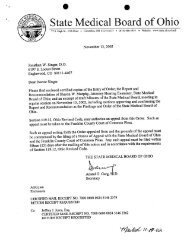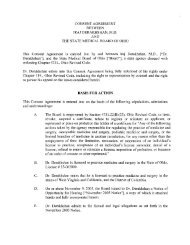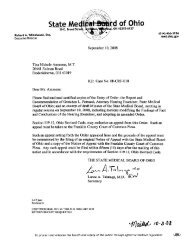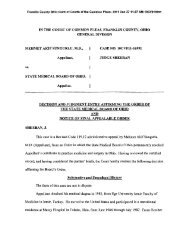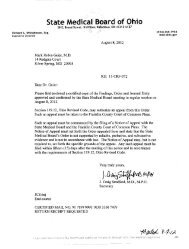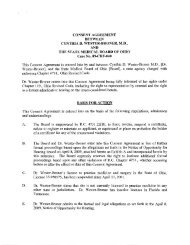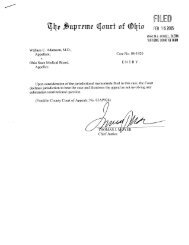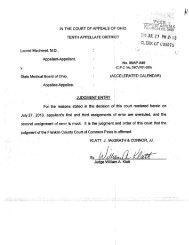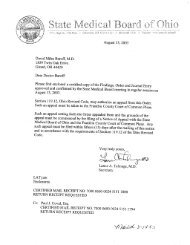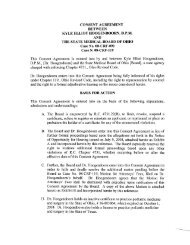Untitled - State Medical Board of Ohio - State of Ohio
Untitled - State Medical Board of Ohio - State of Ohio
Untitled - State Medical Board of Ohio - State of Ohio
You also want an ePaper? Increase the reach of your titles
YUMPU automatically turns print PDFs into web optimized ePapers that Google loves.
Report and Recommendation<br />
In the Matter <strong>of</strong> Jeffrey Vaughn Meyer, M.D.<br />
Page 10<br />
purposes. Also, the laboratory’s GC/MS equipment could not adequately examine the<br />
THC levels in the extracted compound because the laboratory’s GC/MS equipment requires<br />
a liquid and, in the extraction process, the soap became a waxy compound. Consequently,<br />
only results from the preliminary screening test used, AxSYM, were available. Both Drs.<br />
Closson and Staubus stated that AxSYM is another initial screening test used by<br />
laboratories, equivalent to the EMIT test used by B&S. Dr. Closson also stated that<br />
AxSYM is a reliable screening test. (Tr. at 87-88, 134, 200, 229-232)<br />
Dr. Staubus also noted that, on another occasion, The <strong>Ohio</strong> <strong>State</strong> University Reference<br />
Laboratories twice tested the same brand <strong>of</strong> hemp soap for a Franklin County toxicologist.<br />
The results from the three tests indicate that the hemp soap contains THC levels ranging<br />
from 95 to 276 nanograms per milliliter. Dr. Staubus admitted that the extraction<br />
difficulties naturally resulted in varying THC levels, and he stated that he believes the<br />
measurements are low estimates <strong>of</strong> the actual THC concentration in the soap. (Tr. at<br />
233-234, 263; Resp. Ex. G)<br />
25. Moreover, Dr. Staubus noted that an authoritative treatise in the field <strong>of</strong> toxicology<br />
(Disposition <strong>of</strong> Toxic Drugs and Chemicals in Man, Sixth Edition) indicates that roughly<br />
70 percent <strong>of</strong> a dose <strong>of</strong> THC is excreted within 72 hours and the remainder <strong>of</strong> the urinary<br />
metabolites can persist in the urine for several weeks after a single dose. (Resp. Ex. E at 3)<br />
26. Next, Dr. Staubus reviewed two articles related to transdermal absorption <strong>of</strong> THC. He<br />
concluded from those articles that, even if the exposure time is relatively short, THC will<br />
adhere to the fatty portions <strong>of</strong> the skin tissue and slowly dissipate into the bloodstream. He<br />
acknowledged on cross-examination that the methods described in the articles for exposing<br />
the THC to the skin were not the same, the time periods were not the same, and the items<br />
containing the THC were not the same as Dr. Meyer’s use <strong>of</strong> the hemp soap. (Tr. at<br />
243-245)<br />
Regardless, Dr. Staubus noted that the process <strong>of</strong> scrubbing with the hemp soap will<br />
enhance the transdermal absorption <strong>of</strong> the THC because the dead skin cells are removed<br />
and the hot water will enable absorption. Dr. Staubus explained that the fact that it was<br />
difficult to extract the THC from the hemp soap for testing purposes does not negate or<br />
lessen the possibility <strong>of</strong> transdermal absorption <strong>of</strong> the THC in the hemp soap while<br />
showering. As a result, Dr. Staubus found that Dr. Meyer’s use <strong>of</strong> the hemp soap in<br />
October 2006 is, to a reasonable degree <strong>of</strong> scientific certainty, a plausible explanation for<br />
the positive toxicology result for the October 10 urine specimen. (Tr. 218-219, 234-238,<br />
268-269, 277; Resp. Ex. G) Furthermore, Dr. Staubus testified that the creatinine level for<br />
the October 10 specimen was relatively concentrated and, therefore, so were the marijuana<br />
levels. In his view, if Dr. Meyer had consumed one or two more glasses <strong>of</strong> water prior to<br />
providing the specimen, the THC concentration could easily have fallen below the cut<strong>of</strong>f<br />
for a positive result. (Tr. at 238-239; Resp. Ex. G)<br />
27. In relation to the reliability <strong>of</strong> B&S’ toxicology results, Dr. Staubus noted that he did not<br />
receive certain requested information that he felt was necessary to provide a complete



